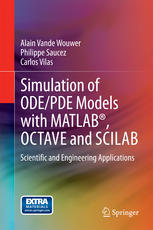

Most ebook files are in PDF format, so you can easily read them using various software such as Foxit Reader or directly on the Google Chrome browser.
Some ebook files are released by publishers in other formats such as .awz, .mobi, .epub, .fb2, etc. You may need to install specific software to read these formats on mobile/PC, such as Calibre.
Please read the tutorial at this link: https://ebookbell.com/faq
We offer FREE conversion to the popular formats you request; however, this may take some time. Therefore, right after payment, please email us, and we will try to provide the service as quickly as possible.
For some exceptional file formats or broken links (if any), please refrain from opening any disputes. Instead, email us first, and we will try to assist within a maximum of 6 hours.
EbookBell Team

5.0
88 reviewsSimulation of ODE/PDE Models with MATLAB®, OCTAVE and SCILAB shows the reader how to exploit a fuller array of numerical methods for the analysis of complex scientific and engineering systems than is conventionally employed. The book is dedicated to numerical simulation of distributed parameter systems described by mixed systems of algebraic equations, ordinary differential equations (ODEs) and partial differential equations (PDEs). Special attention is paid to the numerical method of lines (MOL), a popular approach to the solution of time-dependent PDEs, which proceeds in two basic steps: spatial discretization and time integration.
Besides conventional finite-difference and element techniques, more advanced spatial-approximation methods are examined in some detail, including nonoscillatory schemes and adaptive-grid approaches. A MOL toolbox has been developed within MATLAB®/OCTAVE/SCILAB. In addition to a set of spatial approximations and time integrators, this toolbox includes a collection of application examples, in specific areas, which can serve as templates for developing new programs.
Simulation of ODE/PDE Models with MATLAB®, OCTAVE and SCILAB provides a practical introduction to some advanced computational techniques for dynamic system simulation, supported by many worked examples in the text, and a collection of codes available for download from the book’s page at www.springer.com. This text is suitable for self-study by practicing scientists and engineers and as a final-year undergraduate course or at the graduate level.